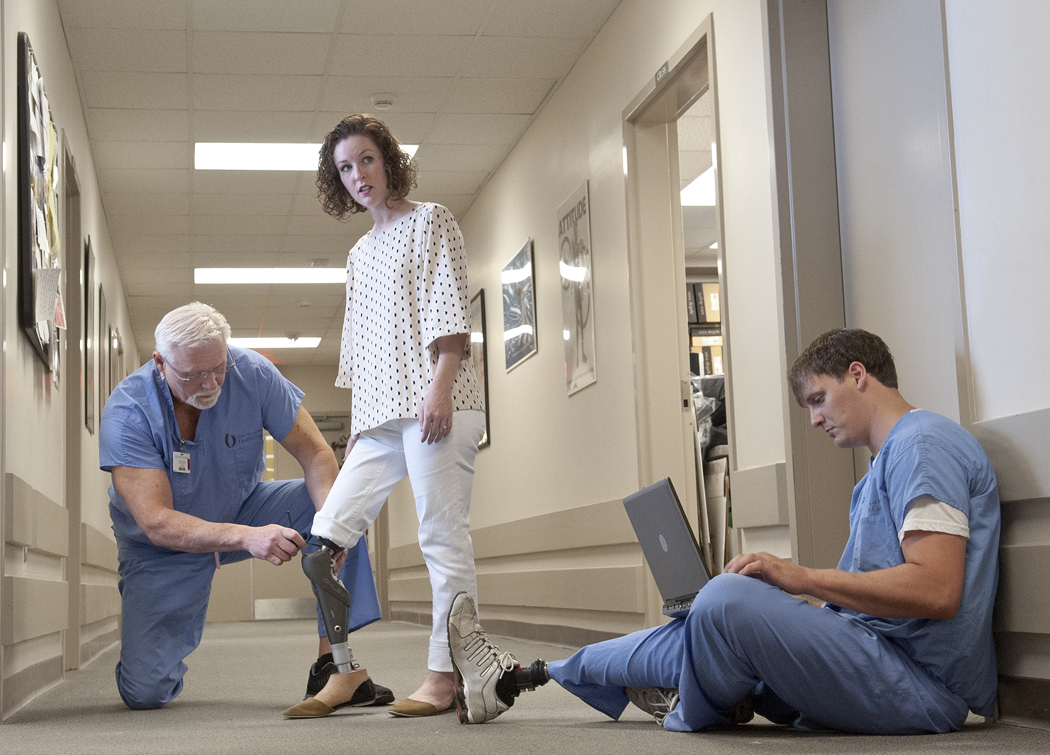Technology, tenacity key on dance floor and in life, says UMMC prosthetics expert

Experts at the University of Mississippi Medical Center’s University Rehabilitation Center also marvel at Purdy’s success on the dance floor. They say a combination of changing technology and determination to push the possibilities make Purdy – and some of their own patients – role models for all.
“She’s an inspiration,” Rick Psonak, a certified prosthetist in the UMMC Department of Orthopedic Surgery’s Division of Orthotics and Prosthetics, says of 34-year-old Purdy, who lost both legs below the knee, and nearly her life, at age 19 to bacterial meningitis.
Blake Carr, 29, a prosthetics assistant at URC whose right leg was amputated below the knee after a four-wheeler accident, works daily with the technology behind the multiple prosthetics Purdy uses for each form of dance the show requires. His prosthetic leg, which he constructed himself in the URC laboratory, allows him maximum movement and flexibility when he hunts, fishes and plays baseball.
“It’s pretty amazing how good she can go with it,” he says of Purdy. “Some of those dance moves are crazy. But, a lot of people are seeing her dance, and they say, ‘Maybe I could dance, too.’ That could be enough to push them.”
Psonak and Carr carefully measure their patients’ limbs to customize a new diagnostic prosthesis to be first worn not long after the amputation procedure. Their patients, including an average of at least five new amputees per month, are fitted with many of the same devices that Purdy and other athletic amputees wear.
They include cheetah running feet or blades used for sprinting and jumping; Flex feet designed to bend and store energy, promoting jogging or daily walking activities; Biom bionic feet with battery-powered motors allowing the wearer to push off with power; articulating feet with ankle joints that allow the feet to move naturally up and down; and feet that adjust for high-heeled shoes.
Cost can be a factor, with the highest-tech devices running tens of thousands of dollars and insurance often just paying on the basics. But Purdy, who can afford expensive devices, hasn’t worn only the fanciest ones on the show. One of the feet costs just $500, media reports cite.
A patient’s relationship with the prosthetic team at URC deepens as they are fitted with longer-lasting, “definitive” prostheses, and often, with devices so state-of-the-art that Psonak test-drives them on Carr. “I’m the lucky guinea pig,” Carr jokes.

Like in Purdy’s situation, Psonak said, amputees need a reason to work at mastering their functional skills with their prosthesis and exploring where technology can lead them. “Some people don’t want devices that offer them better function because they don’t like what they look like,” he said.
In contrast, Purdy has showcased an array of prosthetic components on national television and hasn’t attempted to mask them. She’s even worn feet actually designed for swimming that allowed her to stand on her toes.
“She makes being an amputee look easy, and she’s a double amputee,” said Rachel Gunalda, 26, a Madison resident who lost her right leg above the knee as a high-schooler. Since her 2005 boating accident, Gunalda has been Psonak’s regular patient, seeing him for adjustments and updates to her prosthetic leg.
Sometimes, Psonak and Carr say, they must convince patients to keep living. “I’m dealing with individuals who might be in the darkest moments of their lives,” Psonak said. “They linger there. I compliment them for every little thing they do in their recovery, even wearing their prosthesis for an hour. We coach them. We cheer them.”
Those who watch Purdy can see for themselves what’s possible for an amputee, even if they will never be able to dance or perform athletically at her level. In Carr, URC has its own in-house inspiration for amputees to reclaim their lives and dreams.
“When a (UMMC) trauma patient hasn’t yet lost a limb, but it’s inevitable, we send Blake to talk to him,” Psonak said. “If a patient tells Blake he can’t relate to them, Blake lifts his pants leg up and runs out of the room. Then, the patient usually yells, ‘Wait! Come back!’
“Meeting someone like Blake early on helps them with their fears,” Psonak said. “Blake is so well known that doctors will write a prescription for him to come talk to a patient.”
Gunalda graduated two years ago from UMMC’s physical therapy program. She’s studied Purdy on Dancing with the Stars, noting “she has a significant advantage in having both her knees. But the fact that she has neither leg from below the knee makes it fascinating to me.”
Said Carr: “It’s more of a head game. (People facing amputation) need someone or something they can relate to and hold onto for motivation.”
That, Carr and Psonak say, is what Purdy has shared for the past nine weeks.
“We need these heroes,” Psonak said. “Amy can be an inspiration not just to someone who is an amputee, but to someone who has always wanted to be a dancer.”


